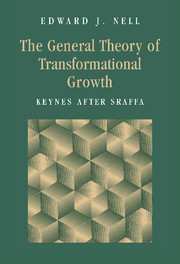Book contents
- Frontmatter
- Contents
- Preface
- Acknowledgments
- Part I History or equilibrium?
- Part II Method and approach: the active mind
- Part III Money and the Golden Rule
- PART IV The wage-profit trade-off
- Part V Investment and Mass Production
- Part VI Money and fluctuations in the modern economy
- Conclusions
- Bibliography
- Index
Part II - Method and approach: the active mind
Published online by Cambridge University Press: 21 January 2010
- Frontmatter
- Contents
- Preface
- Acknowledgments
- Part I History or equilibrium?
- Part II Method and approach: the active mind
- Part III Money and the Golden Rule
- PART IV The wage-profit trade-off
- Part V Investment and Mass Production
- Part VI Money and fluctuations in the modern economy
- Conclusions
- Bibliography
- Index
Summary
The methodology of “scientific economics” adopted the traditional empiricist's view of the mind as the passive recipient of sense impressions, organized by definitions and analytic truths. Sense data provided the basis of our understanding of the external world, the building blocks out of which the edifice of knowledge was constructed. These were classified and manipulated by means of analytic truths, such as those of mathematics, forming the building blocks into patterns and structures which “pictured” the world, that is, were isomorphic to it. Sense data were passively recorded; the structures were built to conform to external reality – the structure of knowledge, even the logical structure of propositions, mimicked the structure of the world. Knowledge was recorded, it was not created. Analytic truths, in turn, were taken to be simply given to the mind and to utterly lack content. Facing the world, the individual mind received sense data as stimuli, and responded by forming them into a picture, using analytical formulae. In this account of knowledge, the mind of the observing agent played no active role.
In the same way, in the picture of the economy sketched by neoclassical theory, the minds of economic agents play no role. They are likewise the recipients of stimuli, to which they respond automatically, applying analytic formulae. The formulae follow from the axioms of rationality – the axioms, in turn, are taken as given.
- Type
- Chapter
- Information
- The General Theory of Transformational GrowthKeynes after Sraffa, pp. 71 - 74Publisher: Cambridge University PressPrint publication year: 1998



